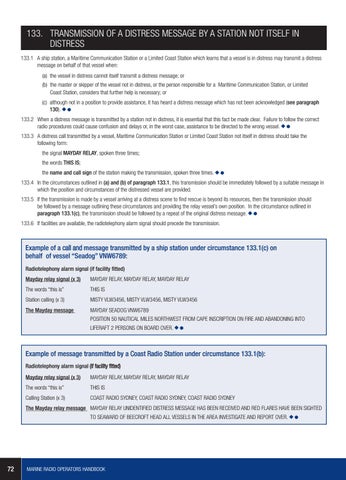133. TRANSMISSION OF A DISTReSS MeSSAGe BY A STATION NOT ITSeLF IN DISTReSS 133.1 A ship station, a Maritime Communication Station or a Limited Coast Station which learns that a vessel is in distress may transmit a distress message on behalf of that vessel when: (a) the vessel in distress cannot itself transmit a distress message; or (b) the master or skipper of the vessel not in distress, or the person responsible for a Maritime Communication Station, or Limited Coast Station, considers that further help is necessary; or (c) a lthough not in a position to provide assistance, it has heard a distress message which has not been acknowledged (see paragraph 130). 133.2 When a distress message is transmitted by a station not in distress, it is essential that this fact be made clear. Failure to follow the correct radio procedures could cause confusion and delays or, in the worst case, assistance to be directed to the wrong vessel. 133.3 A distress call transmitted by a vessel, Maritime Communication Station or Limited Coast Station not itself in distress should take the following form: the signal MAYDAY RELAY, spoken three times; the words THIS IS; the name and call sign of the station making the transmission, spoken three times. 133.4 In the circumstances outlined in (a) and (b) of paragraph 133.1, this transmission should be immediately followed by a suitable message in which the position and circumstances of the distressed vessel are provided. 133.5 If the transmission is made by a vessel arriving at a distress scene to find rescue is beyond its resources, then the transmission should be followed by a message outlining these circumstances and providing the relay vessel’s own position. In the circumstance outlined in paragraph 133.1(c), the transmission should be followed by a repeat of the original distress message. 133.6 If facilities are available, the radiotelephony alarm signal should precede the transmission.
Example of a call and message transmitted by a ship station under circumstance 133.1(c) on behalf of vessel “Seadog” VNW6789: Radiotelephony alarm signal (if facility fitted) Mayday relay signal (x 3)
MAYDAY RELAY, MAYDAY RELAY, MAYDAY RELAY
The words “this is”
THIS IS
Station calling (x 3)
MISTY VLW3456, MISTY VLW3456, MISTY VLW3456
The Mayday message MAYDAY SEADOG VNW6789 POSITION 50 NAUTICAL MILES NORTHWEST FROM CAPE INSCRIPTION ON FIRE AND ABANDONING INTO LIFERAFT 2 PERSONS ON BOARD OVER.
Example of message transmitted by a Coast Radio Station under circumstance 133.1(b): Radiotelephony alarm signal (if facility fitted) Mayday relay signal (x 3)
MAYDAY RELAY, MAYDAY RELAY, MAYDAY RELAY
The words “this is”
THIS IS
Calling Station (x 3)
COAST RADIO SYDNEY, COAST RADIO SYDNEY, COAST RADIO SYDNEY
The Mayday relay message MAYDAY RELAY UNIDENTIFIED DISTRESS MESSAGE HAS BEEN RECEIVED AND RED FLARES HAVE BEEN SIGHTED TO SEAWARD OF BEECROFT HEAD ALL VESSELS IN THE AREA INVESTIGATE AND REPORT OVER.
72
MARINE RADIO OPERATORS HANDBOOK
